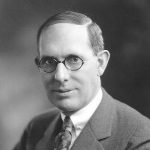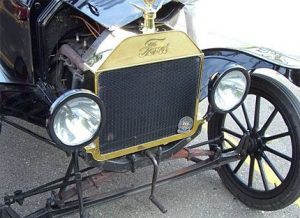 When the automobile first came out, driving them safely wasn’t the only difficulty. The early years of the automobile, found drivers using iron hand cranks to start the internal combustion process that powered the engines on their cars. Getting them started took great hand and arm strength, and the system was not without certain risks. Drivers who forgot to turn the ignition off before turning the crank, could be surprised when the car backfired or rolled forward. You may not know it, but at that time most vehicles had no brakes. Clearly a better system was needed, and in 1911 Cadillac head Henry M Leland gave Charles F Kettering the task of developing one. Kettering was the co-founder of Dayton Engineering Laboratories Company (DELCO) in Dayton, Ohio.
When the automobile first came out, driving them safely wasn’t the only difficulty. The early years of the automobile, found drivers using iron hand cranks to start the internal combustion process that powered the engines on their cars. Getting them started took great hand and arm strength, and the system was not without certain risks. Drivers who forgot to turn the ignition off before turning the crank, could be surprised when the car backfired or rolled forward. You may not know it, but at that time most vehicles had no brakes. Clearly a better system was needed, and in 1911 Cadillac head Henry M Leland gave Charles F Kettering the task of developing one. Kettering was the co-founder of Dayton Engineering Laboratories Company (DELCO) in Dayton, Ohio.
Before founding DELCO with his partner Edward Deeds in 1909, Kettering worked at the National Cash Register Company. While there, he helped develop the first electric cash register. I’m sure that was what called attention to him when Leland was looking for the right inventor for his project. Kettering drew on his experience with the cash register, when approaching his work with automobiles. The new invention wasn’t that big a leap from the cash register either. Just as the touch of a button had started a motor that opened the drawer of the cash register, Kettering would eventually use a key to turn on his self-starting motor. The self-starter was introduced in the 1912 Cadillac, patented by Kettering in 1915, when he was issued U.S. Patent No. 1,150,523 for his “engine-starting device,” the first electric ignition device for automobiles, on August 17, 1915.
The device worked so well that by the 1920s, it would come standard on nearly every new automobile. The device made cars easier and safer to operate, especially for women. The new self-starting engine was a huge hit, and caused a big jump in sales. The new engine was responsible for the fast-growing automobile culture in America. United Motors Corporation, which would become General Motors, bought DELCO in 1916. Kettering was the vice president and director of research at GM from 1920 to 1947. The self-starting engine wasn’t the only invention Kettering headed-up. Other important auto-related innovations developed during Kettering’s  tenure were quick-drying automotive paint, spark plugs, leaded gasoline, shock absorbers, the automatic transmission, four-wheel brakes, the diesel engine and safety glass. He helped develop the refrigerant Freon, used in refrigerators and air conditioners, and the Kettering home in Dayton was the first in the country to be air-conditioned. In the realm of medicine, Kettering created a treatment for venereal disease and an incubator for premature infants, and in 1945 he and longtime General Motors head Alfred P Sloan established the Sloan-Kettering Institute for Cancer Research in New York City. Charles F Kettering died in 1958, having made great contributions toward the improvement of many lives.
tenure were quick-drying automotive paint, spark plugs, leaded gasoline, shock absorbers, the automatic transmission, four-wheel brakes, the diesel engine and safety glass. He helped develop the refrigerant Freon, used in refrigerators and air conditioners, and the Kettering home in Dayton was the first in the country to be air-conditioned. In the realm of medicine, Kettering created a treatment for venereal disease and an incubator for premature infants, and in 1945 he and longtime General Motors head Alfred P Sloan established the Sloan-Kettering Institute for Cancer Research in New York City. Charles F Kettering died in 1958, having made great contributions toward the improvement of many lives.


Leave a Reply